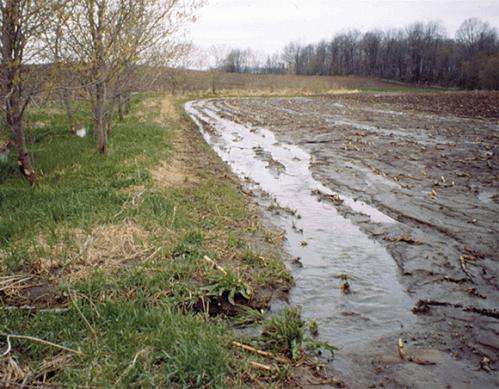Breaking down differences in modeling soil water substantially shifts carbon stored in land

The starting point very often changes the finish. A team led by researchers at Pacific Northwest National Laboratory modeled runoff, that is, water's movement over the land surface and through the subsurface, using two widely adopted methods. They found that the modeling choices result in differences that ultimately swing results in carbon cycle simulations—by as much as 20 percent. The differences in modeling runoff methods cause substantial differences in the soil moisture that also changes soil temperature. Their study was published in the Journal of Advances in Modeling Earth Systems.
"Changing soil moisture and soil temperature in the model leads to changes in leaf photosynthesis and the length of the growing season that ultimately change the amount of carbon dioxide 'fixed' by plants," said Dr. Maoyi Huang, climate modeler at PNNL. "So, when it comes to modeling and understanding the carbon cycle, we show how it also matters what you start with in modeling water."
Moisture is an important element in making sure the planet provides adequate food and water is plentiful. It is also a vital ingredient for the climate system-an important component of the Earth's water cycle. By influencing the amount of water available to evaporate or be taken up by plants, soil moisture is vital for the water and energy cycles, and in turn affects carbon through interactions that occur in the soils and plants.
The impacts of soil moisture on the carbon cycle are well known from previous research. However, interactions among soil moisture, groundwater, and runoff are typically neglected or greatly oversimplified in model simulations. Researchers in this study investigated how the choice of the runoff generation design influences the carbon cycle through changes in soil moisture and other land surface and subsurface states. In the current generation of land models, the uncertainty in hydrologic representations with coupled hydrologic, ecologic, and biogeochemical processes can lead to a large range of soil moisture results and subsequently the land carbon cycle. This variable range could translate into large consequences for long-term climate projections.
Led by researchers at PNNL, the scientists conducted two simulations with different runoff generation parameterizations, a way to represent processes that occur at much finer spatial scales than can be explicitly expressed in the model. They used two macro-scale hydrological models: TOPMODEL and the variable infiltration capacity model, denoted as CLM4 and CLM4VIC. The models were operated under the same experimental protocol as the NASA-sponsored North American Carbon Program Multi-Scale Synthesis and Terrestrial Model Intercomparison (MsTMIP) project. The study tested the sensitivity of the simulated global water balance to the choice of runoff generation design, and analyzed how the changes in simulated water balance affected Gross Primary Production (GPP), the amount of carbon dioxide "fixed" by the plants (see sidebar).
At a high spatial resolution, they simulated historical carbon and hydrological processes driven by a 110-year (1901-2010) atmospheric forcing dataset, prescribing other time-varying environmental drivers, including annual land-use and land-cover change, monthly atmospheric nitrogen deposition, and atmospheric CO2 concentration. Starting in 1901, they repeatedly fed the model a randomized sequence of climate forcing data between the years 1901-1930 so that climate trends and extremes were eliminated.
"Our study highlights the significant interactions among the water, energy, and carbon cycles and the need for reducing uncertainty in the land surface models' hydrologic parameters to better constrain carbon cycle modeling," said Huang.
Data Use
Six data model or remote sensing products were used for benchmarking the simulations:
- The University of New Hampshire (UNH)/Global Runoff Data Centre (GRDC) composite runoff data
- Global land evapotranspiration (ET) and GPP data derived from the FLUXNET eddy covariance flux towers (i.e., FLUXNET-MTE ET and GPP)
- The Moderate Resolution Imaging Spectroradiometer (MODIS) GPP and ET data
- The global leaf area index dataset derived from Global Inventory Modeling and Mapping Studies (GIMMS3g) NDVI data
- The terrestrial water storage from the Gravity Recovery and Climate Experiment (GRACE)
- The gridded mean annual baseflow index (defined as the ratio of subsurface flow to total runoff) estimated from streamflow observations globally.
The researchers will incorporate the runoff parameterization into a new U.S. Department of Energy (DOE) Earth system model called the Accelerated Climate Model for Energy, or ACME, and fine-tune ways to better understand hydrologic states simulations.
More information: Lei H, M Huang, LR Leung, D Yang, X Shi, J Mao, DJ Hayes, CR Schwalm, Y Wei, and S Liu. 2014. "Sensitivity of Global Terrestrial Gross Primary Production to Hydrologic States Simulated by the Community Land Model using Two Runoff Parameterizations." Journal of Advances in Modeling Earth Systems, early view. DOI: 10.1002/2013MS000252.
Provided by Pacific Northwest National Laboratory





















